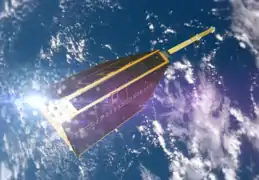 Artist's impression of CHAMP | |
| Mission type | Technology |
|---|---|
| Operator | DLR |
| COSPAR ID | 2000-039B |
| SATCAT no. | 26405 |
| Mission duration | Achieved: 10 years Planned: 5 years |
| Spacecraft properties | |
| Bus | Flexbus[1] |
| Manufacturer | Astrium |
| Launch mass | 500 kilograms (1,100 lb) |
| Start of mission | |
| Launch date | 15 July 2000, 12:00:00 UTC |
| Rocket | Kosmos-3M |
| Launch site | Plesetsk 132/1 |
| End of mission | |
| Decay date | 19 September 2010 |
| Orbital parameters | |
| Reference system | Geocentric |
| Regime | Low Earth |
| Semi-major axis | 6,823.287 kilometres (4,239.794 mi) |
| Eccentricity | 0.0007115 |
| Inclination | 87.18 degrees |
| Period | 93.55 minutes |
| RAAN | 124.21 degrees |
| Argument of perigee | 277.62 degrees |
| Epoch | 15 July 2000 12:00:00 UTC[2] |
Challenging Minisatellite Payload (CHAMP) was a German satellite launched July 15, 2000 from Plesetsk, Russia and was used for atmospheric and ionospheric research, as well as other geoscientific applications, such as GPS radio occultation, gravity field determination, and studying the Earth's magnetic field.[3][4]
CHAMP was managed by GeoForschungsZentrum (GFZ) Potsdam.[5]
The spacecraft is the first application of Astrium's "Flexbus" platform; GRACE was the second.[6] A heavily modified version flew as the GOCE mission.[7]
Spacecraft instruments
An onboard BlackJack Global Positioning System (GPS) Flight Receiver, provided by JPL, enables the use of satellite to satellite tracking for vehicle positioning. To remove the effect of external, non-gravitational forces (e.g., atmospheric drag, solar radiation pressure) the satellite features an internal 3-axis STAR accelerometer. Independent verification of orbital position is enabled by a passive Laser Retro Reflector (LRR), which also enables calibration of the principal positioning via laser ranging. Spacecraft attitude is measured using Advanced Stellar Compass (ASC) supplied by Technical University of Denmark.[4]
Mounted on the boom, the satellite has an Magnetometer Instrument Assembly System (MIAS) for measurement of the Earth's magnetic field. The vehicle can measure the Earth's electric field parallel to the magnetic field with the Digital Ion Drift Meter (DIDM).[4]
End of mission
CHAMP completed its mission and re-entered the Earth's atmosphere on 19 September 2010 after 10 years (design life: five years).[8]
The mission was judged as being successful by the involved scientists,[9] in particular as the original 5 year design life was significantly extended.[10]
References
- ↑ "The 'Grace twins' to investigate the Earth system". Spaceflight Now. Pole Star Publications Ltd. Archived from the original on 26 January 2021. Retrieved 1 October 2022.
- ↑ "Launch/Orbital Information for CHAMP". nssdc.gsfc.nasa.gov. NASA. Archived from the original on 2023-06-14. Retrieved 2023-08-01.
- ↑ Reigber, Christoph; Lühr, Hermann; Schwintzer, Peter, eds. (2003). First CHAMP Mission Results for Gravity, Magnetic and Atmospheric Studies. Springer Berlin, Heidelberg. pp. XIII, 563. doi:10.1007/978-3-540-38366-6. ISBN 978-3-540-38366-6. Archived from the original on 2023-08-01. Retrieved 2023-08-01.
- 1 2 3 "CHAMP". Satellite Missions Catalogue. ESA. Archived from the original on 1 October 2022. Retrieved 1 October 2022.
- ↑ "CHAMP - CHAllenging Minisatellite Payload". GFZ German Research Centre for Geosciences. Archived from the original on 1 October 2022. Retrieved 1 October 2022.
- ↑ Usbeck, T.; Wohlfart, J.; Schelkle, M. (2004). "A Flexible Cold Gas Propulsion System Concept for Different Space Applications". 4th International Spacecraft Propulsion Conference. 555. Bibcode:2004ESASP.555E..76U. Archived from the original on 1 October 2022. Retrieved 1 October 2022.
- ↑ Ilčev, Stojče Dimov (December 5, 2018). Global Satellite Meteorological Observation (GSMO) Applications Volume 2. Springer International Publishing. p. 544. ISBN 9783319670478. Archived from the original on May 10, 2023. Retrieved February 24, 2023.
- ↑ "Upcoming and Recent Reentries | The Aerospace Corporation". Reentrynews.aero.org. Archived from the original on 2012-05-13. Retrieved 2013-08-01.
- ↑ "CHAMP: A Fiery End". GFZ German Research Centre for Geosciences. GFZ. Archived from the original on 1 October 2022. Retrieved 1 October 2022.
- ↑ Reigber, Christoph; Lühr, Hermann; Grunwaldt, Ludwig; Förste, Christoph; König, Rolf; Massmann, Heiner; Falck, Carsten (2006). "CHAMP Mission 5 Years in Orbit". Observation of the Earth System from Space. pp. 3–15. Bibcode:2006oess.book....3R. doi:10.1007/3-540-29522-4_1. ISBN 3-540-29520-8. Archived from the original on 8 October 2022. Retrieved 2 October 2022.
External links
- Official site Archived 2023-04-01 at the Wayback Machine
- NASA website